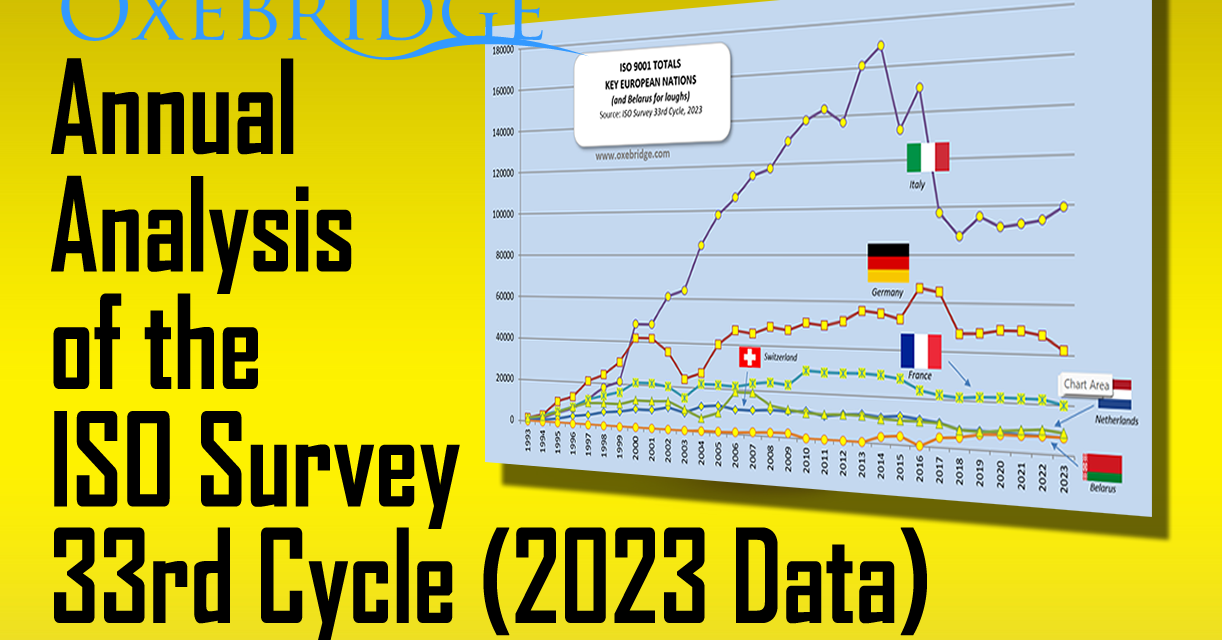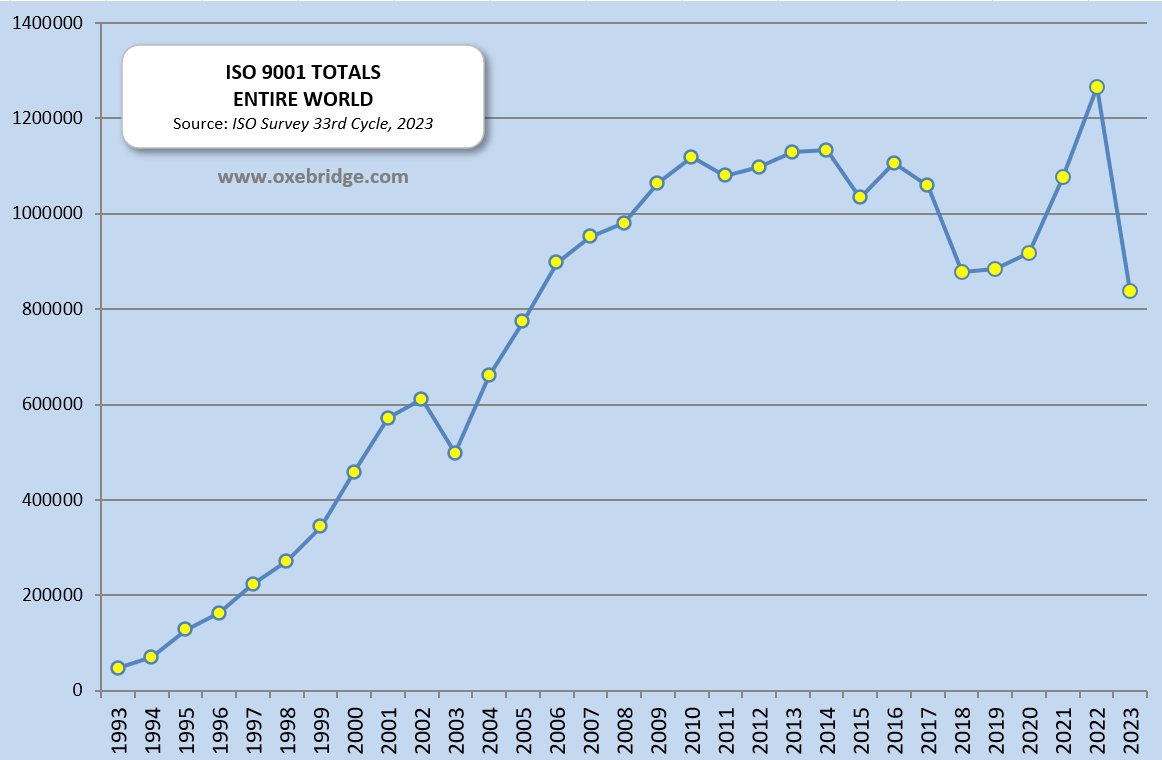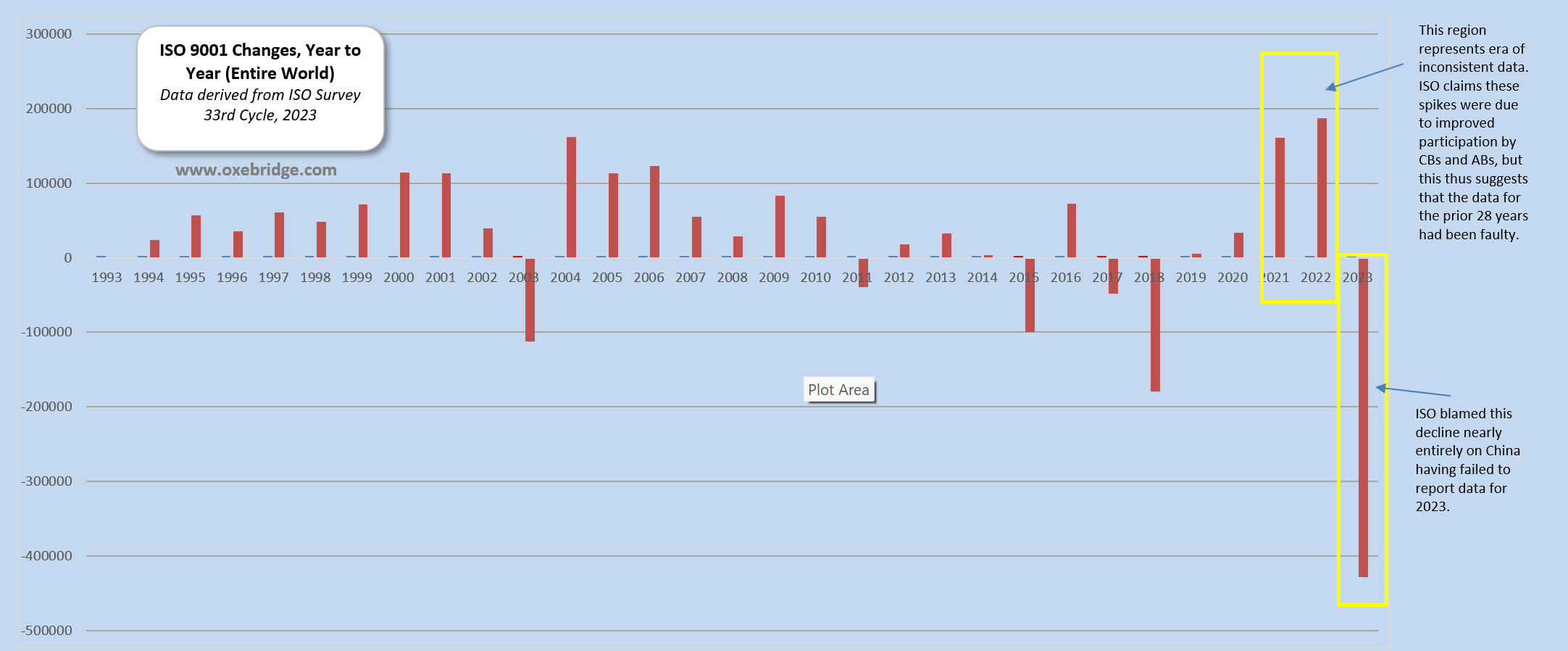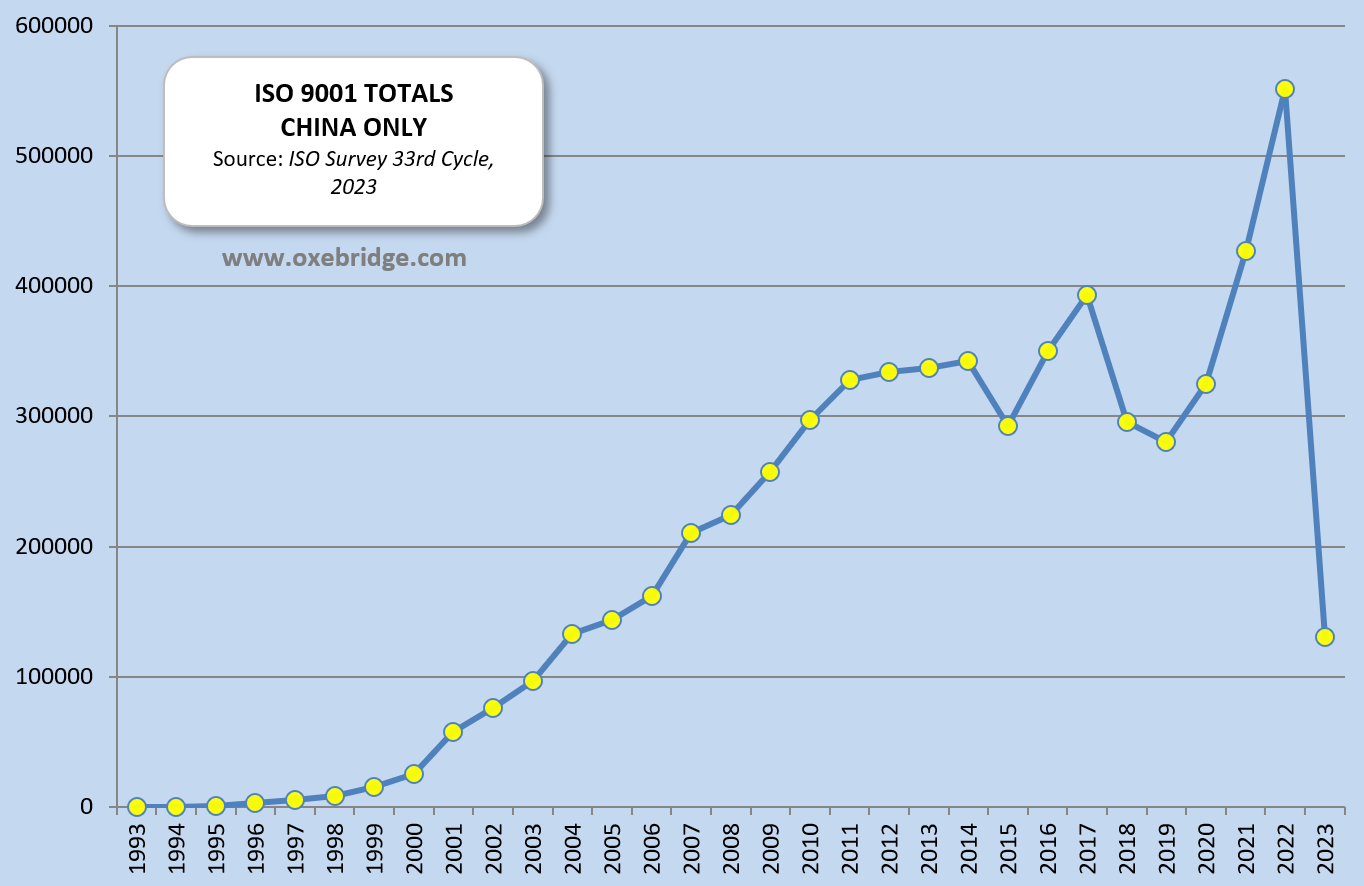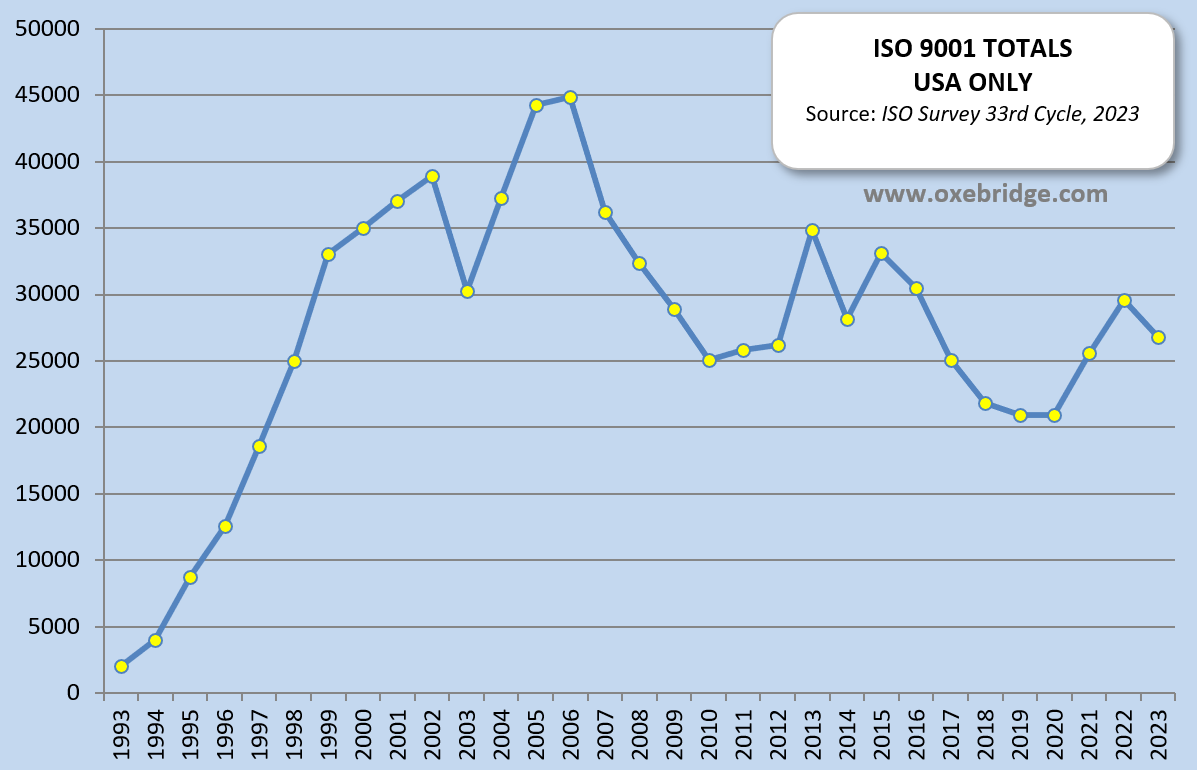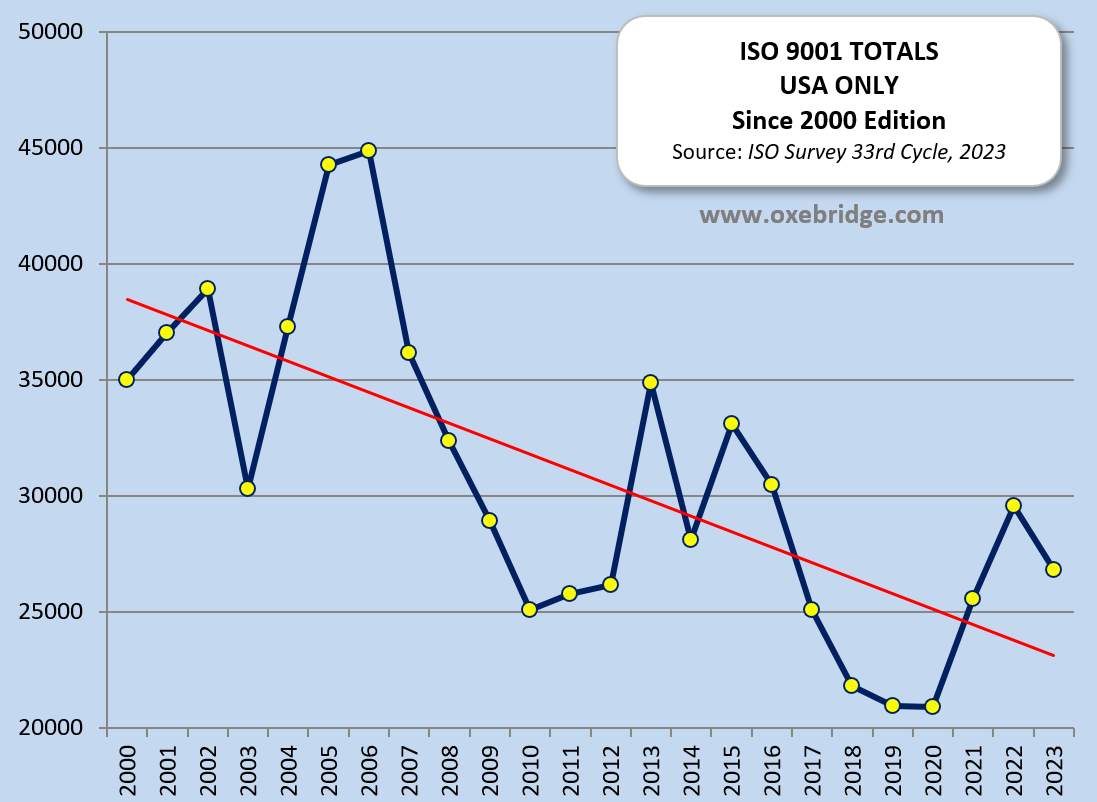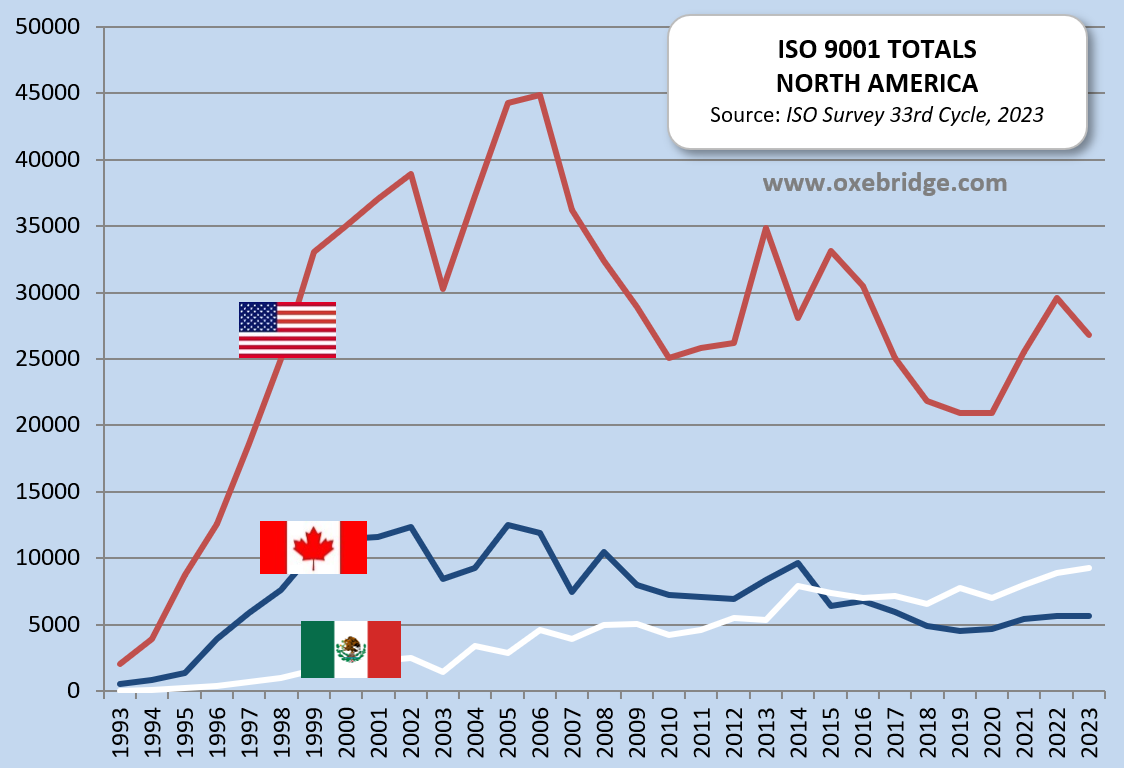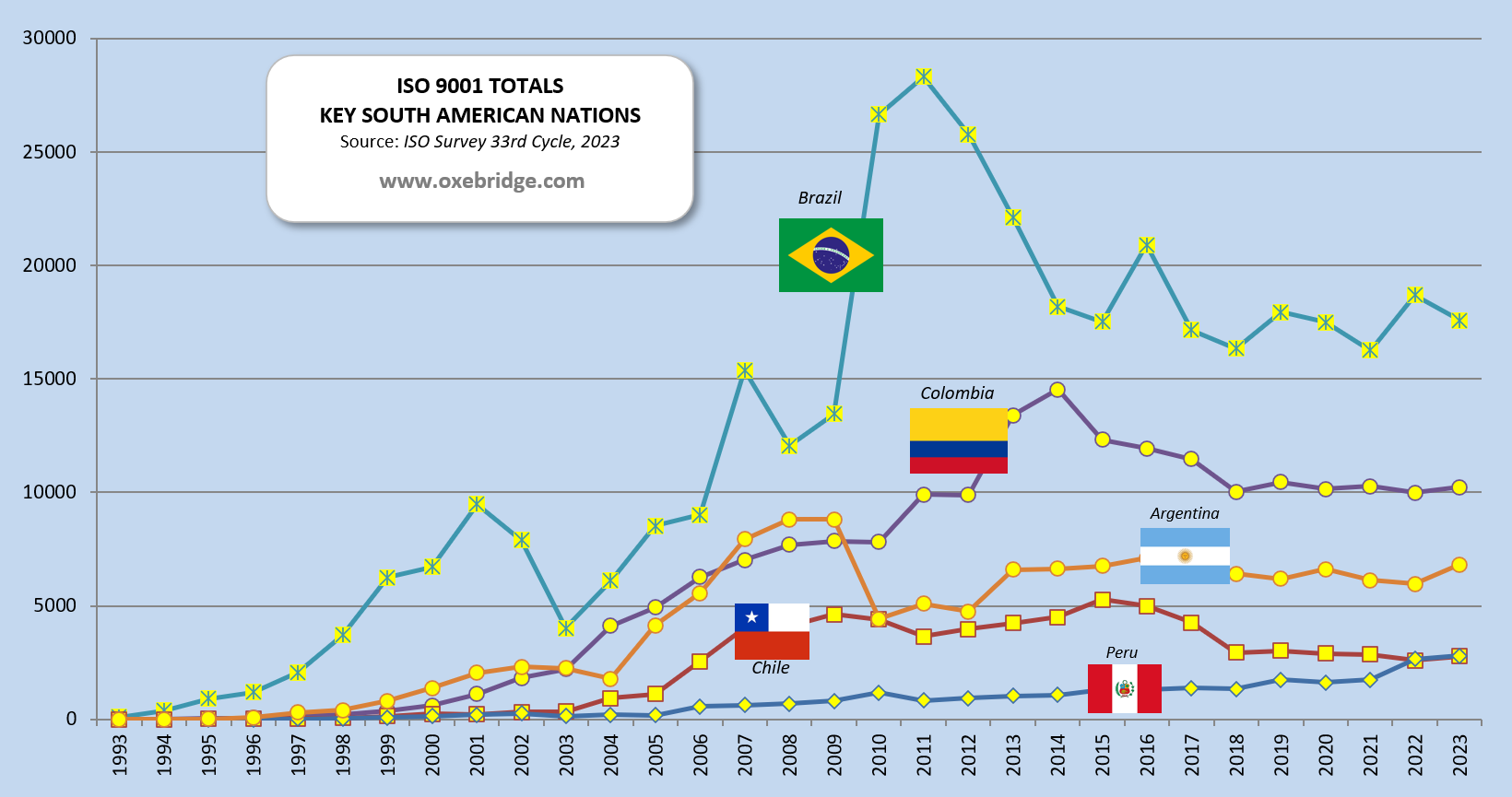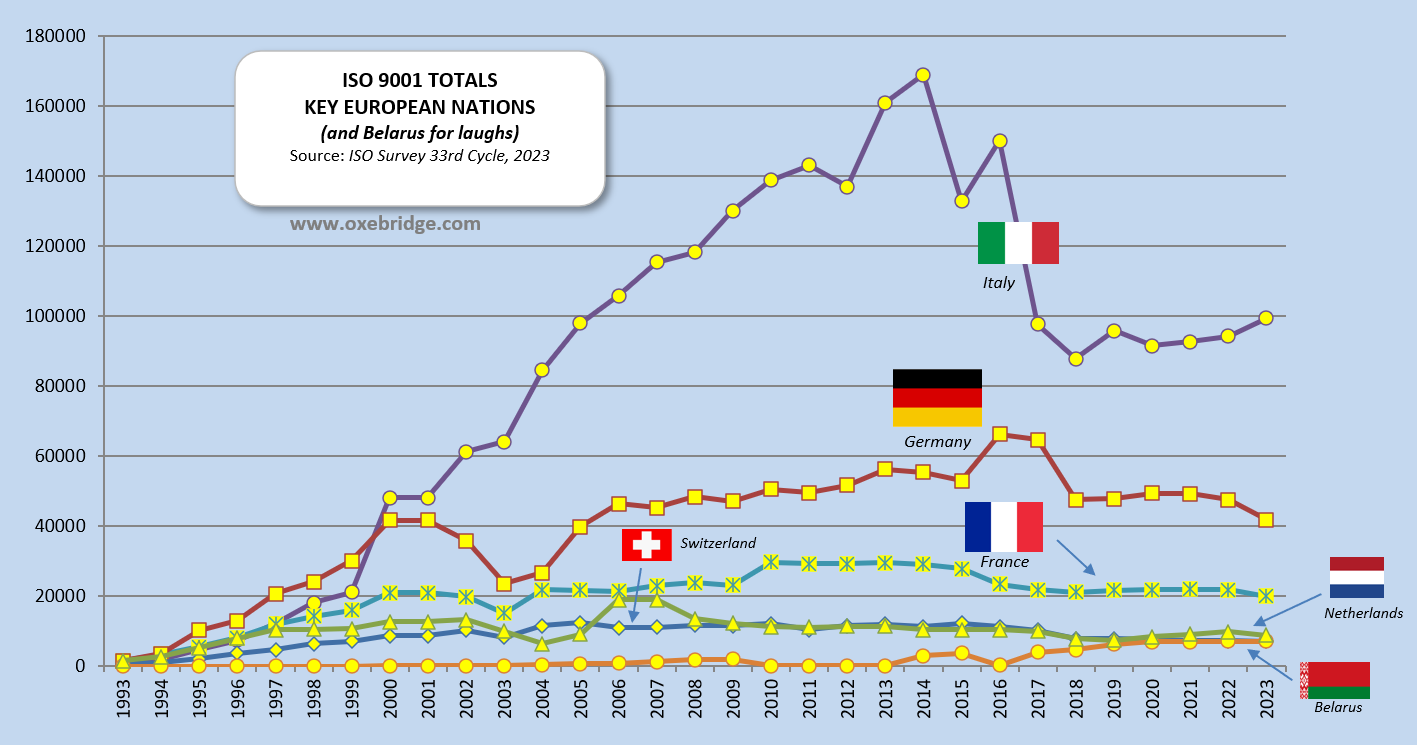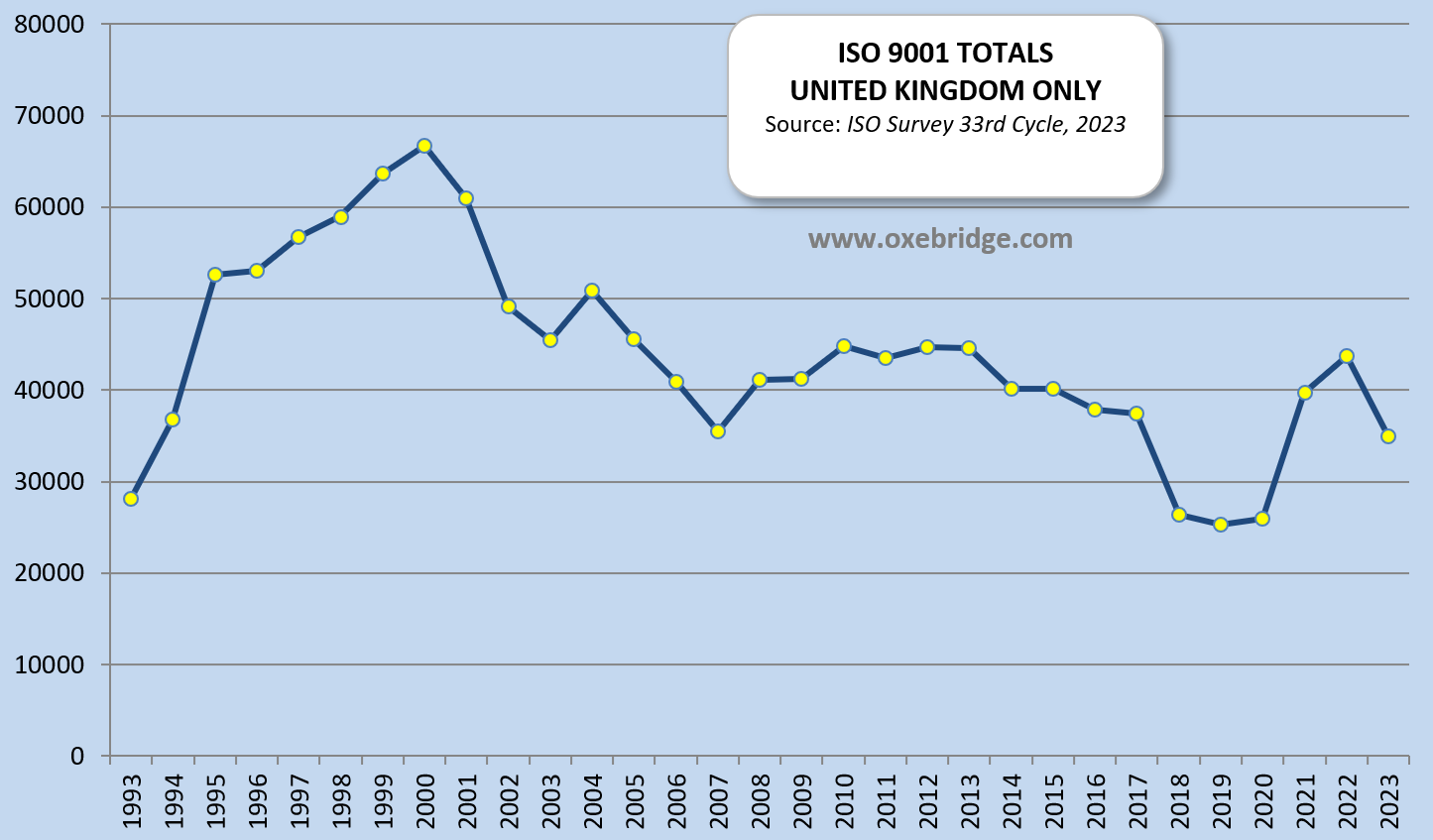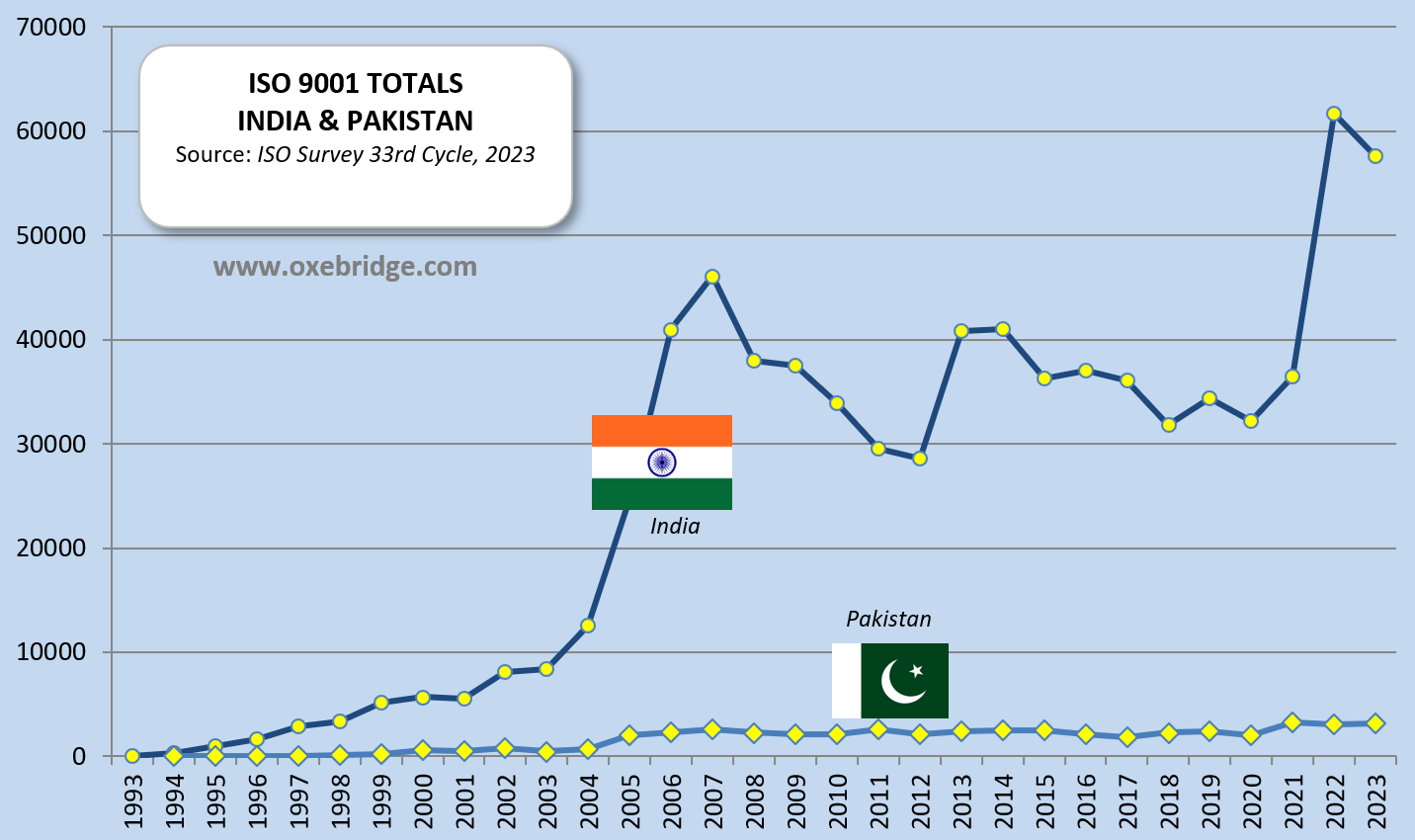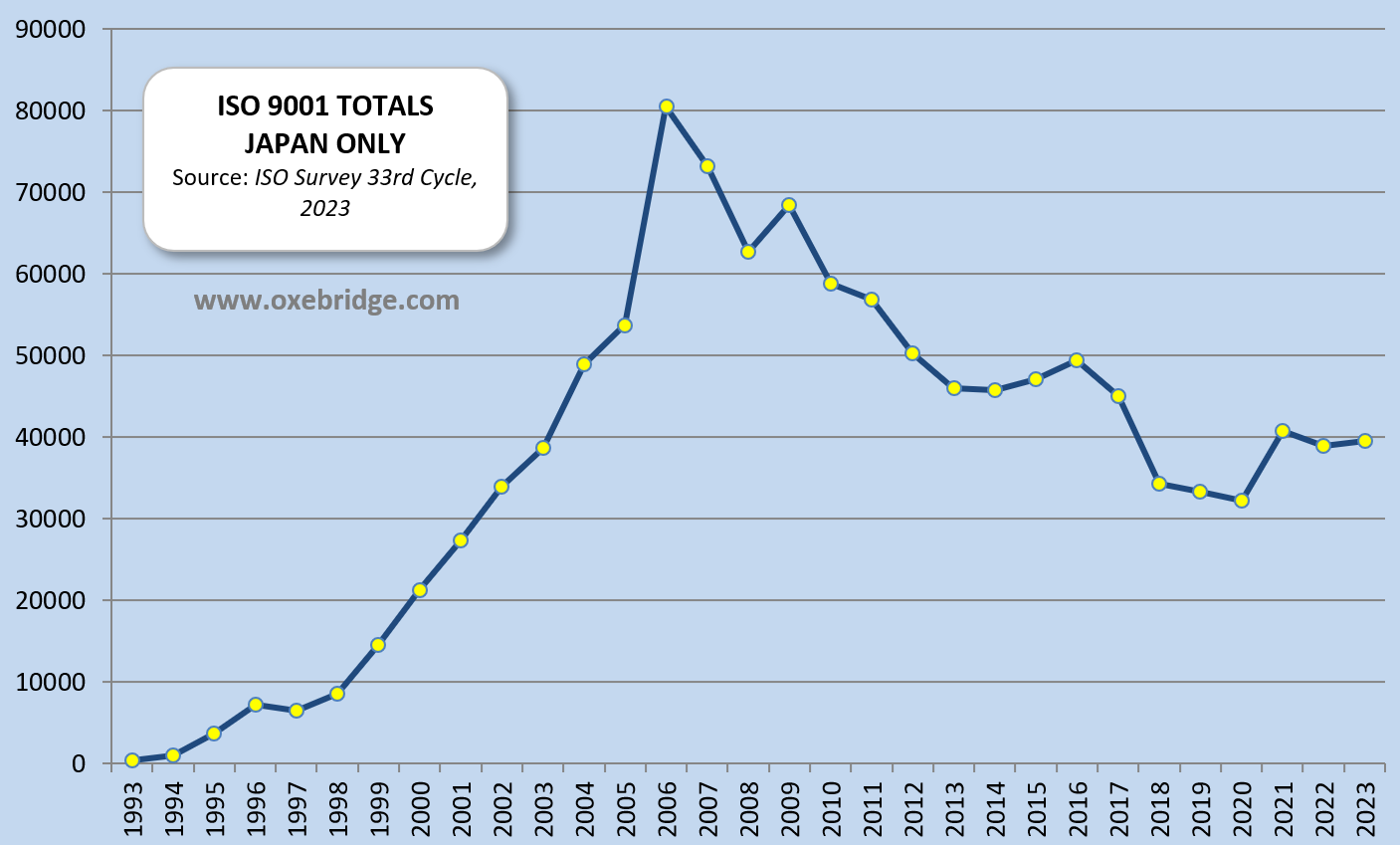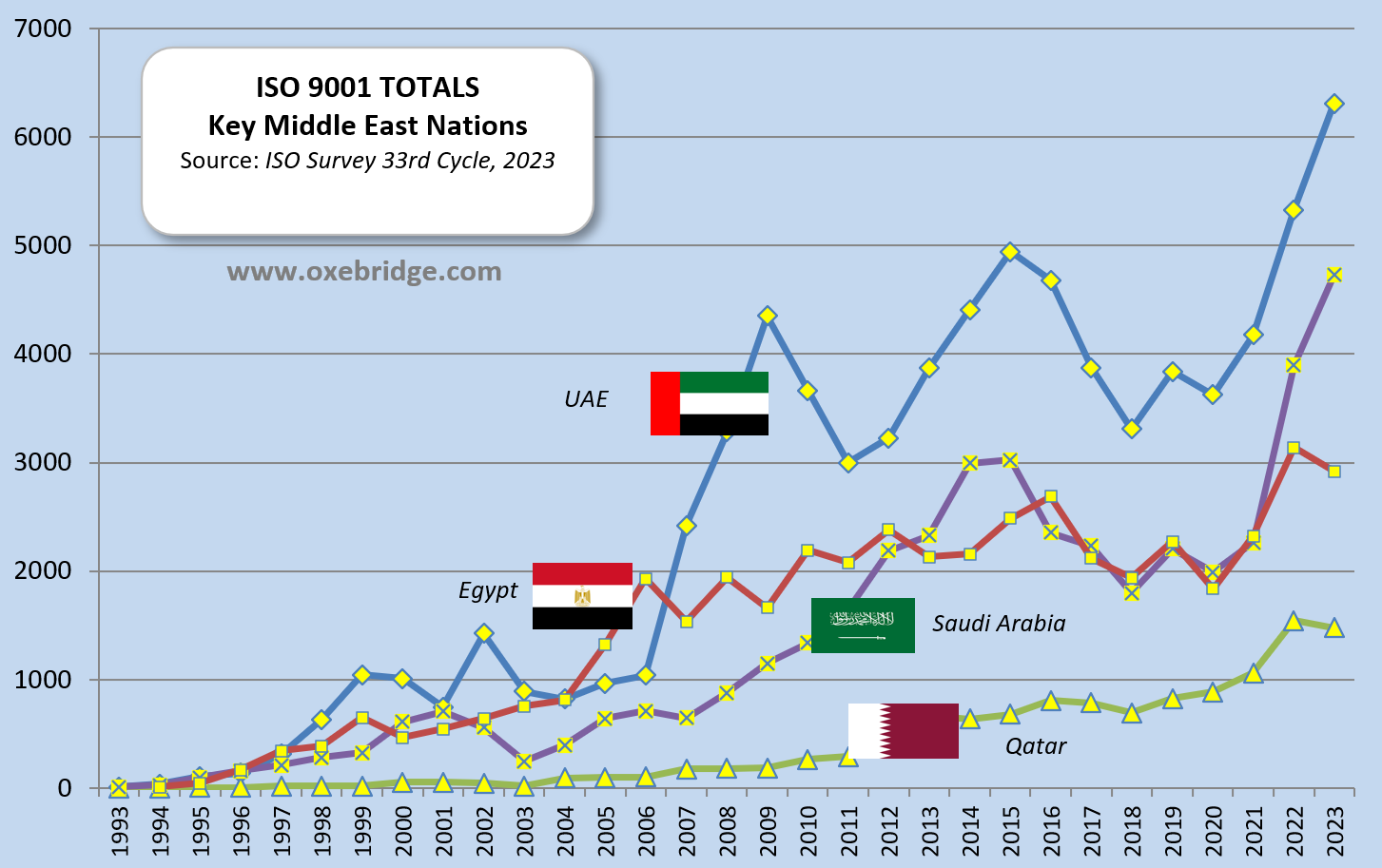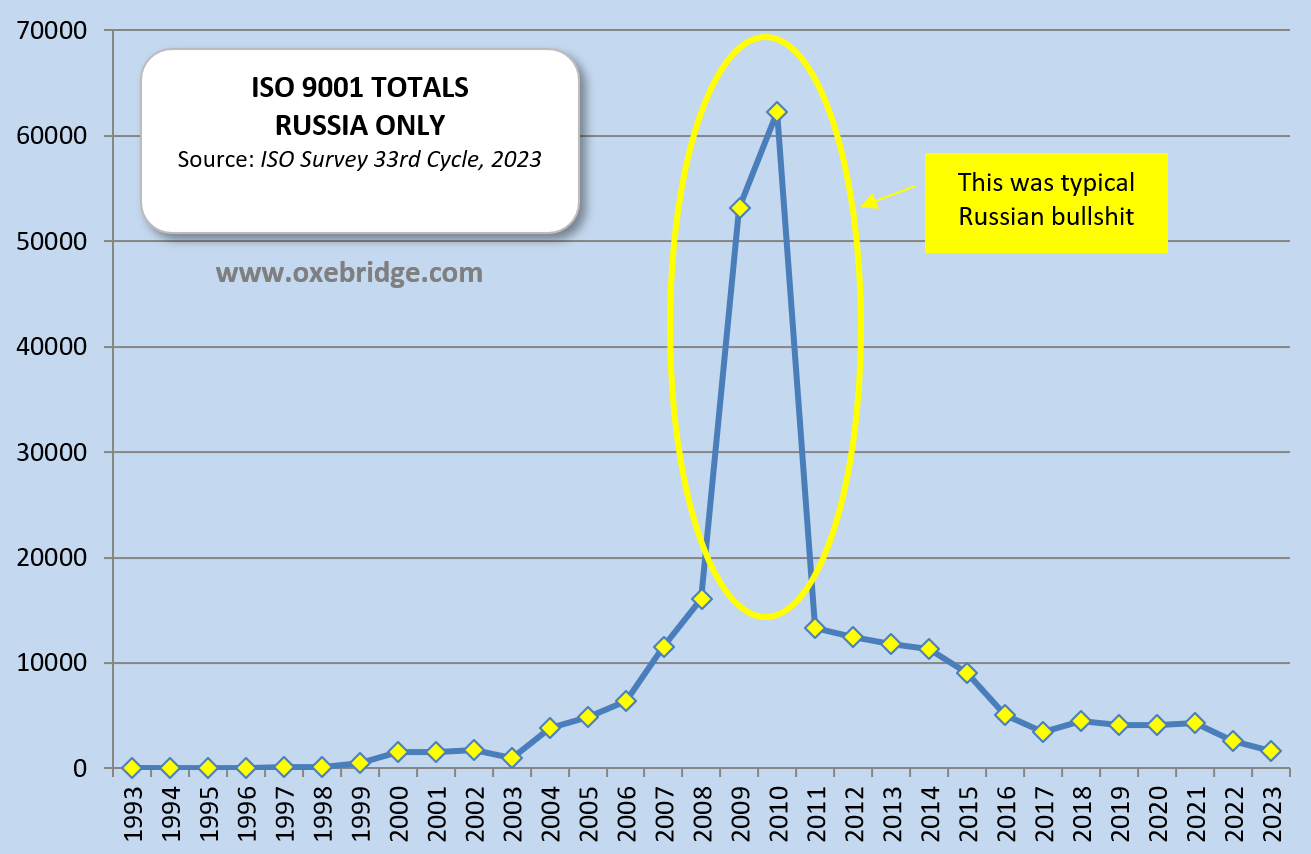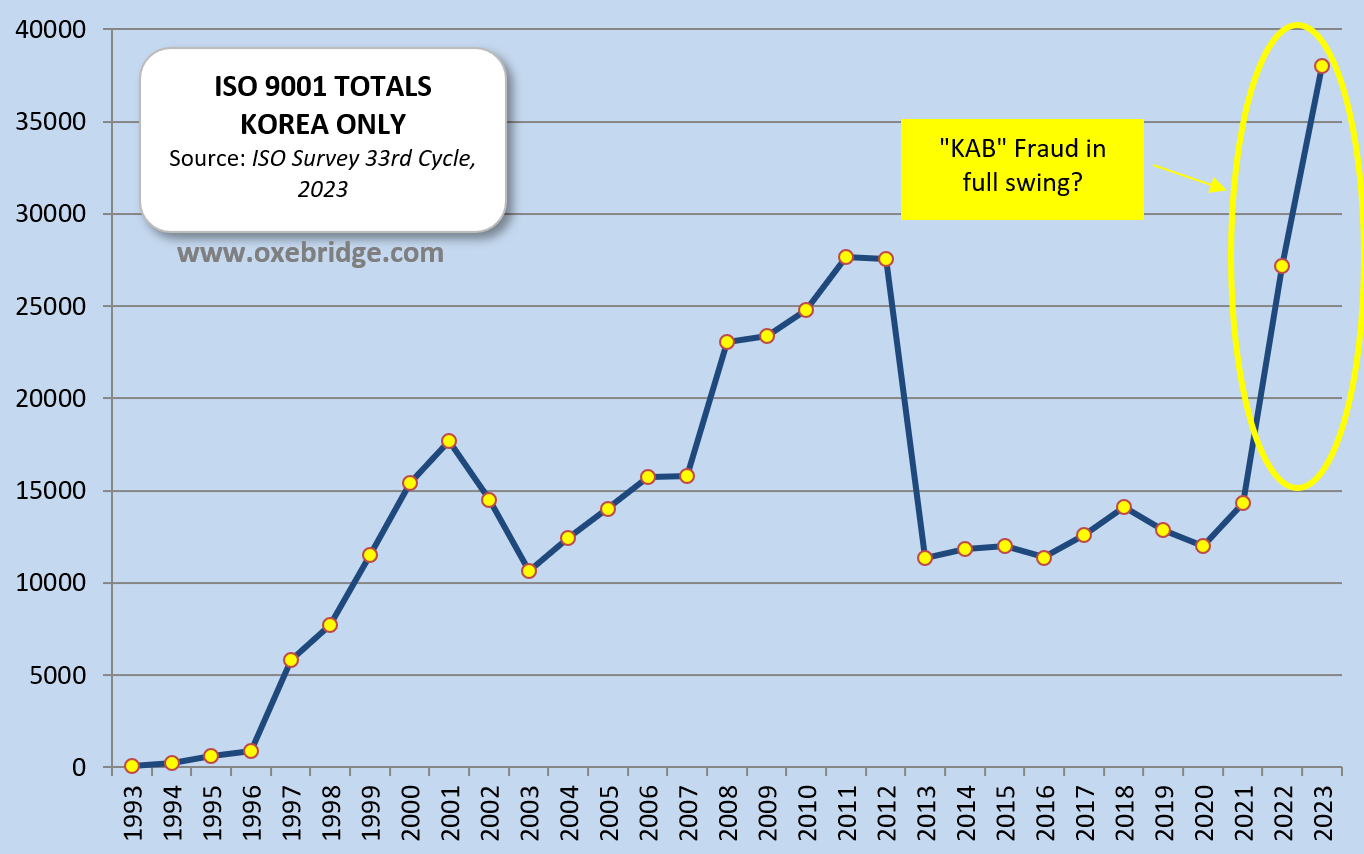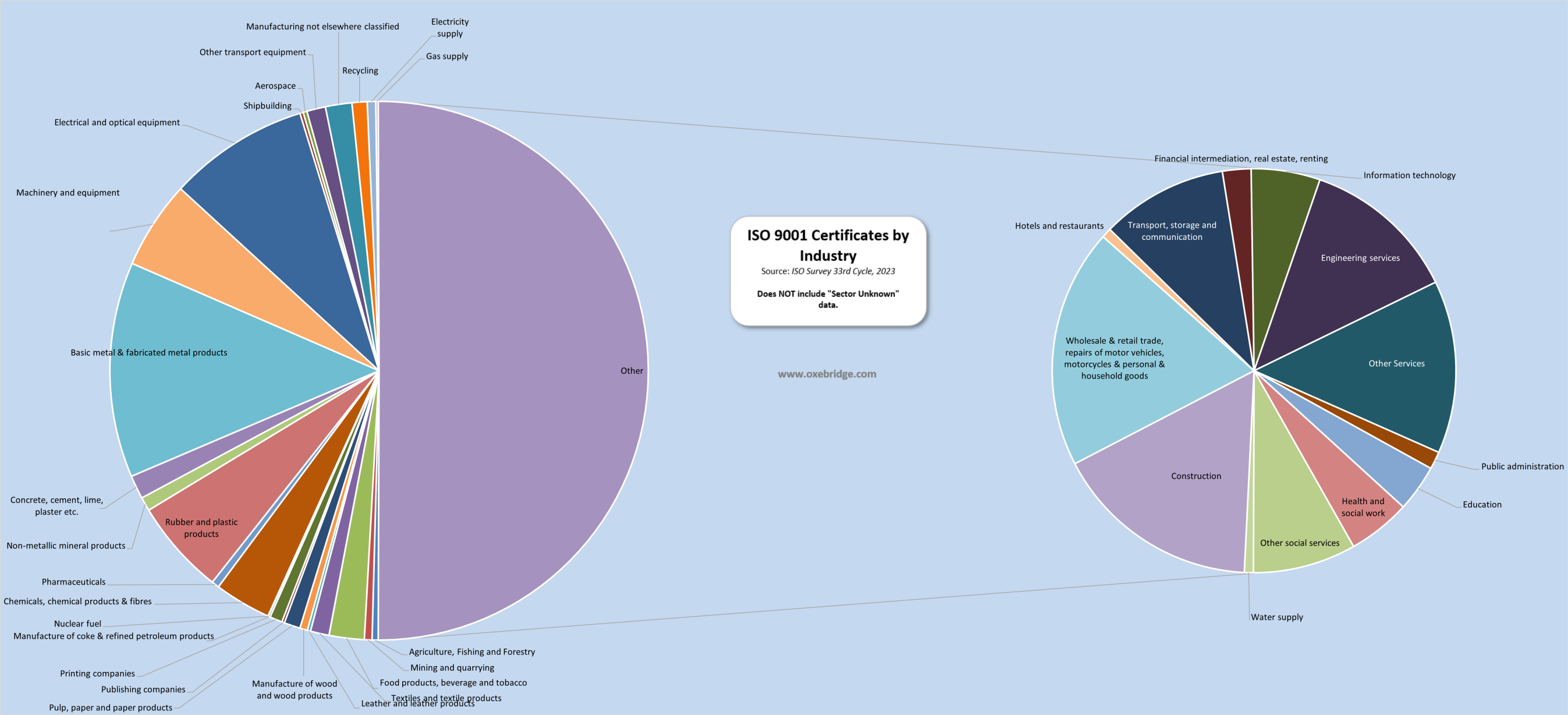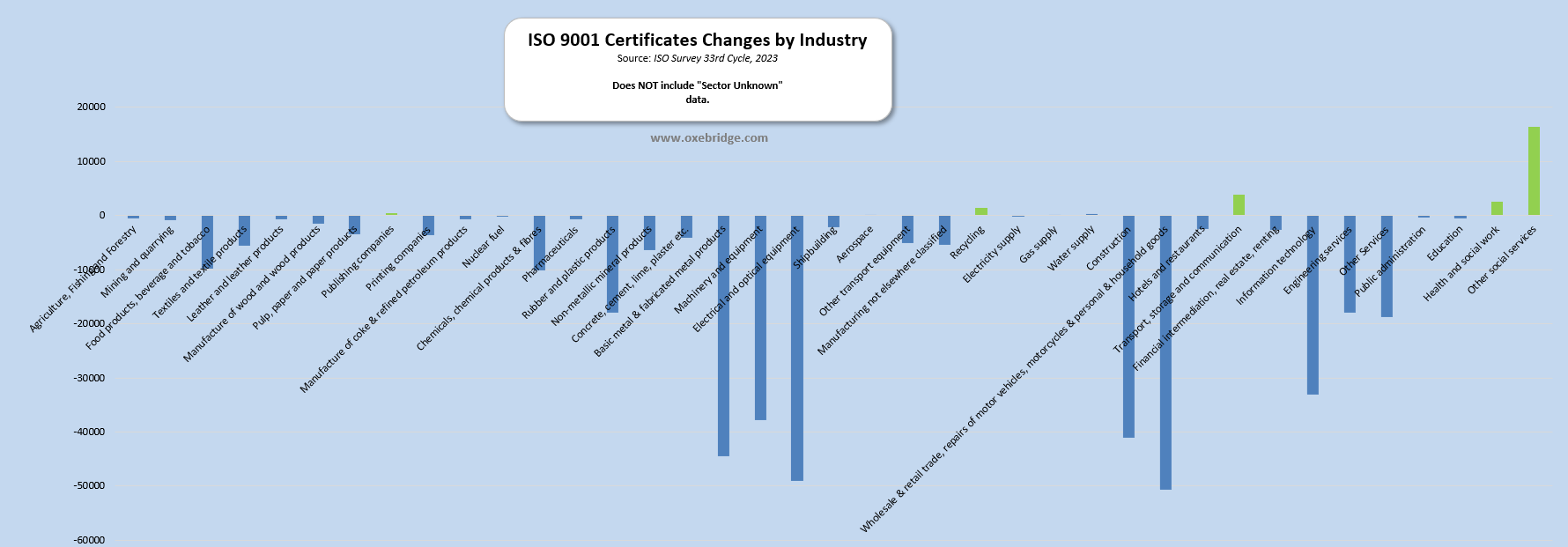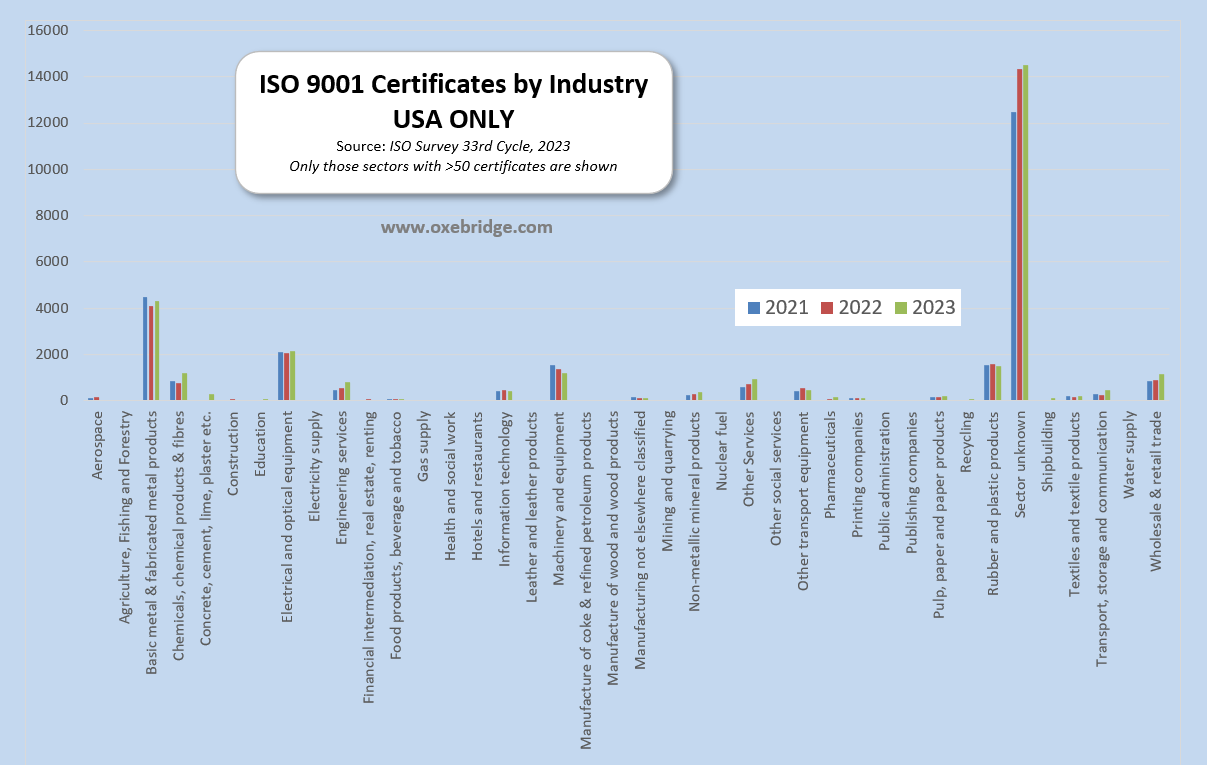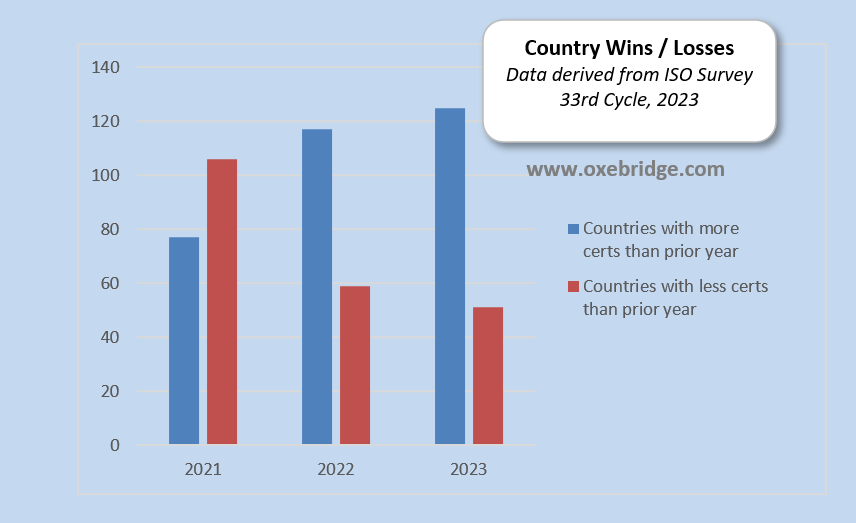ISO has released its 33rd annual ISO Survey, providing data on total certificates worldwide for ISO 9001, ISO 14001, and other standards. The latest report includes data as of 2023. Every year, since 2002, Oxebridge follows up with its analysis of the data, using its own database comprised of ISO Survey data going back to 1993.
This year, the data is completely screwed up due to a sudden loss in certificates reported by China. For the past few years, ISO has relied on China’s data to prop up otherwise sagging numbers around the world. We all know the Chinese numbers are fake and that neither IAF nor ISO has the means of verifying anything coming out of the CCP, but ISO has been hanging its hat on Beijing for a while now. This year, China pulled the rug out from under them; according to a cringy “ISO CASCO Explanatory Note” that accompanies the Survey, “results were impacted by the missing participation of the accreditation body of China, who was not able to share its data for the ISO Survey.”
I have no idea what “not able to share its data” means, and I will have to poke around to find out what really happened.
As a result, the overall total of ISO 9001 certificates is down to 837,048, a huge drop that brings it below the oft-lauded “1 million” mark.
Now, the data I will be presenting is a tad bit different from that reported by ISO, but also likely a bit more accurate. Keep reading to find out why.
Also, if you rely on Oxebridge’s annual analysis of the ISO Survey or just like the content here, be sure to follow me on LinkedIn, and jump onto our Slack or Discord channels for real-time chat.
History
The ISO Survey was originally launched in 1990 as The Mobil Survey, published by Mobil Oil Co. ISO took over the reporting in 1996, and has published the Survey ever since. Initially, the surveys were labeled as “cycles,” a naming convention that ISO dropped, but which Oxebridge maintains for nostalgia and consistency. The 2023 data represents the 33rd Cycle by that naming system.
As mentioned, since 2002, Oxebridge has released a corresponding “ISO Survey Analysis” report, which tries to look past ISO’s generic (and often misleading) press release blurbs to see the real trends behind the data. While ISO has changed its reporting methods over the years — in 2018, for example, ISO stopped reporting prior years’ data entirely — Oxebridge has been carefully collecting the data since 1993, and then merges the data so that it remains consistent. That allows us to have more accurate trend reporting over the full period from 1993 to the present.
Deprecated Data Tracks
Two years ago, ISO caused a major upheaval in its reporting. To explain a (frankly improbable) surge in supposedly-accredited ISO 9001 certificates, ISO claimed that “improved reporting” by UKAS, through its CertCheck database, simultaneously improved the data. Then, last year, ISO did the same and blamed the IAF CertSearch database, saying that was the reason for an unlikely spike in data.
These claims imply the data over the past decades was faulty, which is unlikely. When the number of CB was smaller, they were much easier to gather data from. The proliferation of CBs — both accredited and unaccredited — has caused chaos in the market, and both ISO and IAF are struggling to rein in the lunatics without alienating them. It’s clearly not working.
For the past two years, Oxebridge struggled to maintain some consistency with the data going back to the 1990s. Because we have the full data going back to The Mobil Survey, we were able to crunch the numbers and provide data showing the data from two angles: first, based on “consistent” certification data, which relied on behind-the-scenes data coming out ISO; and second, “inconsistent” data that accepted ISO’s inflated spikes at face value.
Last year, ISO itself adopted this posture (you’re welcome) and began providing two reports: one based on data from CBs who participated in prior years’ ISO Surveys, and another — the one with higher totals — allegedly showing data from the increased pool of participating ABs and CBs. They did the same with this year’s 33rd Cycle report.
This year, I felt the ISO Survey data has re-stablized, so we are only presenting one set of numbers again. Thanks to ISO and IAF mucking with the numbers, we really don’t have an accurate year-over-year picture going back to 1993, but I think it will more or less normalize as we see more years added.
One note: ISO reports on certified “sites.” Oxebridge historically ignores this data and we only report on certificates. Reporting on sites is just a way to artificially inflate the numbers.
World Outlook
ISO now reports a total of 837,049 certificates to ISO 9001. That is a loss of over 428,000 certificates — over a third! — from last year’s total of 1,265,216. As I said, ISO blames China, but it could also mean China finally stopped reporting fake certificates, and the numbers are actually real (-ish) this year.
Here is what the year-to-year changes look like (click to enlarge):
For data nerds, this is frustrating. We can see the problems raised by IAF since 2021; prior to them claiming CertSearch would provide accurate data, we actually had accurate data. They have been wholly unable to get data from their members, despite claiming that providing it is “mandatory,” and they’ve just mucked it all up. This is because ISO gave up gathering the data itself, and let IAF and their clowns do it.
China
I can’t be really sure what is going on in China, and ISO’s explanation for the sudden change in data is not compelling. We know the numbers coming out of China have been fake, so maybe they started honest reporting all of a sudden?
I doubt it. I suspect we will see them spike back up to stratospheric levels next year, and the charade will just continue.
In the meantime, here is what the China numbers look like, to date:
USA
The US numbers get really weird, thanks to ISO’s shifting reporting methods. ISO’s “Explanatory Note” claimed that the US numbers had increased “due to the increase in the data reported by some providers and by some certification bodies that did not participate the year before.” But using stabilized data, the US actually lost over 2,700 certificates, bringing it down to 26,833. It didn’t increase at all, despite ISO’s press release. But it’s not the first time ISO has lied about the data in their own report.
This is far from the US’ peak of nearly 45,000 certificates in 2006. We continue to see the damning effects of the edits made to ISO 9001 since the 2000 edition.
This next chart shows the trend only since the 2000 version of ISO 9001, which is still seen as the best version ever released of that standard. The trendline still has flattened, even with the new numbers.
North America
Comparing the US to its North American neighbors, the data appears as follows:
Not too much to see there.
South America
For the first time, we’re reporting on key South American countries. You’d think that since I live down here, I would have done this sooner.
Brazil continues to dominate, with Colombia showing a strong second. Argentina holds third place, with Chile and Peru recreating the War of the Pacific and fighting for dominance. For the first time ever, Peru has surpassed its historical rival Chile, but only by a mere 21 certificates.
ISO’s Secretary-General, Sergio Mujica, is from Chile, so you’d think his country would be a bit more interesting in his end product. They are not.
European Bellwethers
Every year, we report on a few key European nations to gauge how things are going on the continent where ISO 9001 was born; these are Italy, Germany, France, and ISO’s home country of Switzerland. The chart below shows this data, and I’ve added the Netherlands this year, since they have such an outsized influence on the actual text of ISO 9001 revisions. And, as always, we throw the corrupt bastards from Belarus in there so we can make fun of their sorry asses.
Italy continues to be Europe’s darling ISO 9001 adopter, but they are still nowhere near their heyday of the 2010s.
As I’ve said in prior years, the overall picture is that Europe — once the home of ISO 9001 — has most definitely lost its interest in the standard.
United Kingdom
For the UK, we saw a ridiculous spike over the past two years that didn’t make much sense. The ISO gods claimed this was due to improved reporting through the UKAS CertSearch database. Now it’s looking like those spikes were false, and the numbers we see in 2023 are the real ones. With a total of only 34,956 ISO 9001 certificates, it’s not a warm picture for ISO in that country.
India & Pakistan
Last year we saw India embrace fraud and start reporting what are absolutely fake numbers. This year is no different, but we see a very tiny dip. The total (57,658) is likely polluted by half, which I suspect are fake certificates issued under full IAF-member accreditation marks. India gave up giving a shit about its reputation in the world, and so lies and lies and lies.
India now claims to have 57,658 ISO 9001 certificates.
To really piss off India, I thought I’d compare them against the more sober numbers of their best buds in Pakistan. While the population of India is greater than that of Pakistan, and you’d thus expect to see higher numbers in India, Pakistan’s gentle, spikeless data seems to suggest it isn’t polluted with the fake certificate mill problem that plagues India.
Japan
Japan’s numbers are stabilizing once again, with a total of 39,584 ISO 9001 certificates.
Middle Eastern Bellwethers
I like tracking key Middle Eastern countries, since so much of the fraud facing the ISO scheme comes from those nations. Here we track major abusers of ethics, and peddlers of fraudulent certificates: UAE, Saudi Arabia, Qatar, and — for the first time — Egypt. I added Egypt this year because their accreditation body (EGAC) is proving to be one of the worst on the planet. We see spikes in the past few years coming from all of them, with only minor corrections this year in Egypt and Qatar.
Russia
Ahh, Vladimir Putin, the love child of a bag of injectable silicone and Satan. Their numbers continue to drop, which is likely due to a number of unforced errors Putin made for his country. First, he invaded Ukraine which caused companies to pull out of Russia entirely. Then Russian Register was kicked out of the IAF club (sort of) and they moved to a full-on certificate mill model, so their numbers don’t appear at all, anymore. Hard to feel sorry for them.
The Asian Watchlist
Last year, we began tracking five specific Asian countries that are suspected of being producers of fake certificates despite IAF member accreditation. This year, we see a few spikes that would imply this is still a problem, but Thailand did see an actual drop. Whereas in 2022, they had 2,619 certificates; in 2023, that dropped down to a humiliating 1,677. That means Slovenia now has more ISO 9001 certs than Russia. Snort.
South Korea
I started reporting on South Korea separately last year, after I noticed the numbers coming out of that country make no sense. We also saw a huge spike in fake certificates and deadly certified products coming out of Korea, all bearing the mark of bodies accredited by the Korean Accreditation Board (KAB). It seems their CEO, Jin Suh Park, has embraced fraud and is just allowing KAB to overlook all sorts of fakery, so long as he gets the Korean numbers up.
Korea claims to have 38,041 ISO 9001 certificates, an 87% jump over where they were just two years ago. I call bullshit.
Sector Analysis
ISO and IAF still can’t measure sectors properly. This has been an ongoing joke for decades, and I’m not sure why it presents such a problem. For a while, they stopped reporting on this entirely. Then they fell back into it, and I thought they finally had consistent data again and I reported it as such last year. But this year I noticed a glaring problem: the total certificates issued to sectors is grossly higher than the total certificates issued by country; the two numbers should be identical.
So who knows what is going on?
The chart below provides the data from 2023 on industrial sectors with ISO 9001 certificates. I removed the data for “Sector Unknown,” which represented over a third of the data. Click to enlarge.
As a result of the bizarre numbers, it’s hard to see which industries are gaining vs. losing. If the 2023 data is to be believed, “construction” dropped by nearly half from last year, “manufacturing not elsewhere classified” lost over 5,000 certs, while “other social services” gained 16,314 certs. This doesn’t make any sense on its face. What is likely is that two factors are to blame here: first, that CBs don’t know how to classify clients properly, and second, that many of today’s CBs are fraudsters and are assigning the wrong IAF industry codes to clients in order to make sure they fit into the CB’s scope of accreditation. It costs money to add an industry code to a CB, so a CB can now get accredited for only one code (such as “other social services”) and then lie and claim that all of its clients fall under that category, even if they are in aerospace or shipbuilding. The IAF doesn’t apply any punitive measures to CBs who lie, so this is likely the reason for this corrupt data.
So, I really don’t know what to make of this year’s ups-and-downs chart by industry, and it probably should not be relied on at all. There are only nine sectors that had more certificates than the prior year (shown in green): “other social services,” “transport,” “storage and communication,” “health and social work,” “recycling,” “publishing companies,” “water supply,” “aerospace, and “gas supply.” For some, the increases are so small they don’t show up on the chart at this scale.
In studying just the sector trends in the USA, we see the following. The only point of value is that it appears the US is losing its ability to track sectors since the main spike was for “Sector Unknown” certifications. I suspect the drop in some sectors just means those certificates landed in that pile instead.
Gains / Losses Trending
This year’s data is such a mess, it really needs careful parsing. Unfortunately, the following view isn’t going to help much either.
In this chart, we look at the past three Surveys to see if more countries are gaining ISO 9001 or losing it. We saw the majority of countries in 2021 had lost more certificates than they gained, but that reversed in 2022 and 2023.
Winners and Losers
The top ten nations with the most certificates as of 2023 break down as follows:
- China – 130,402 certificates (down 421,453 from last year)
- Italy – 99,419 certificates (up 5,203 from last year)
- India – 57,658 certificates (down 3,995 from last year)
- Germany – 41,760 certificates (down 5,816 from last year)
- Japan – 39,584 certificates (up 668 from last year)
- South Korea – 38,041 certificates (up 10,886 from last year)
- United Kingdom – 34,956 certificates (down 8,809 from last year)
- Spain – 30,341 certificates (down 1,718 from last year)
- USA – 26833 certificates (down 2,746 from last year)
- France – 19,987certificates (down 1,893 from last year)
These are the same ten countries as last year, with only minor pole position changes at Japan and Korea crept up a bit. We can see, however, that despite their position, the majority of these countries lost certificates, rather than gained them. Brazil got bumped off this list in 2022 and remains off.
Growth rates by nation are not very useful to measure, since tiny countries like Lao or Nepal saw huge rates after adding only a handful of certs. Lao, for example, added only 51 certs, but that represented a 638% growth rate since they only had 8 certificates reported in the prior year.
But looking at total certs added in 2021, the top countries for raw growth are as follows:
- Korea added 10,886 certificates
- Italy added 5,203 certificates
- Romania added 3,184 certificates
- Portugal added 2,672 certificates
- Poland added 1,782 certificates
- UAE added 984 certificates
- Uzbekistan added 872 certificates
- Saudi Arabia added 833 certificates
- Thailand added 694 certificates
- The Philippines added 682 certificates
For the first time, China, UK, USA, Italy, and Brazil are not on the growth list at all. I think the Phillippines is a country to watch, as they seem to be gaining many certifications, and there’s no evidence (to date) that they are fake.
The top ten losers — representing the countries that lost the most certificates — are as follows:
- China lost 421,453 certificates
- UK lost 8,809 certificates
- Germany lost 5,816 certificates
- India lost 3,995 certificates
- USA lost 2,746 certificates
- Australia lost 1,928 certificates
- Czech Republic lost 1,924 certificates
- France lost 1,893 certificates
- Spain lost 1,718 certificates
- Brazil lost 1,116 certificates
Summary
There really is only one story to tell from this data: despite having done a pretty good job between the years of 1993 through 2012 or so, ISO has lost all ability to properly collect and present the data in an honest way. Once Sergio Mujica took over in 2017, things got much, much worse. He stopped reporting on year-over-year data at all to hide annual global losses, and his spokesman Laurent Charles has leaned into absolute bullshit in the accompanying press releases and “Explanatory Notes.”
If the IAF “global database” CertSearch was supposed to improve these numbers, it has done the opposite. The IAF has refused to enforce a rule that makes participation in CertSearch mandatory, because — let’s face it — do they really have the power to kick China or the UK out of the ISO certification market if they don’t play ball? ISO made a huge mistake relying on this data to replace its own data-gathering methods from the past, and we continue to see just how badly the IAF data is corrupting the overall dataset.
In 2023, we also saw IAF members and their regional bodies like EA, APAC, and IAAC embrace the certificate mills and abandon, nearly entirely, their one job: to ensure only valid, trustworthy CBs issue accredited ISO 9001 certificates. So whereas in the old days, you could trust that data in the ISO Survey only reflected fully accredited, valid certificates — the mills were shut out — now, the mills have just gained full IAF membership and are pumping out fake certs with UKAS and ANAB logos on them. There’s no control at all, so even the ISO Survey data is overpopulated with fake certs now.
Frustrating!
Here are a few of the prior Oxebridge analyses of previous ISO Surveys:
- Oxebridge Analysis of ISO Survey 2018: Facing 20% Loss of ISO 9001 Certs Worldwide, ISO Dismantles Data Trending
- Oxebridge Analysis of ISO Survey 2019: Bleeding is Slowing, But Patient is on Life Support
- Oxebridge Analysis of ISO Survey 2020: China to the Rescue
- Oxebridge Analysis of ISO Survey 2021: China, UKAS Corrupt the Data
- Oxebridge Analysis of ISO Survey 2022: IAF CertSearch Gunks Up the Works
Christopher Paris is the founder and VP Operations of Oxebridge. He has over 35 years’ experience implementing ISO 9001 and AS9100 systems, and helps establish certification and accreditation bodies with the ISO 17000 series. He is a vocal advocate for the development and use of standards from the point of view of actual users. He is the writer and artist of THE AUDITOR comic strip, and is currently writing the DR. CUBA pulp novel series. Visit www.drcuba.world

